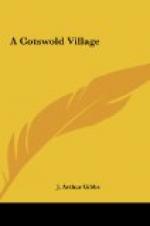The south porch is a very beautiful and ornamental piece of architecture. The work is of fifteenth-century design, the interior of the porch consisting of delicately wrought fan-tracery groining. The carving outside is most picturesque, there being many handsome niches and six fine oriel windows. The whole of the facade is crowned with very large pierced battlements and crocketed pinnacles. Over this porch is one of those grand old sixteenth-century halls such as were built in former times in front of the churches. It is called the “Parvise,” a word derived from the same source as Paradise, which in the language of architecture means a cloistered court adjoining a church. Many of these beautiful old apartments existed at one time in England, but were pulled down by religious enthusiasts because they were considered to be out of place when attached to the church and used for secular purposes. This is now known as the town hall, and contrasts very favourably with the hideous erections built in modern times in some of our English towns for this purpose.
The church of Cirencester contains a large amount of beautiful Perpendicular work.
In the grand old tower are twelve bells of excellent tone. The Early English stonework in the chancel and chapels is very curious, a fine arch opening from the nave to the tower. There is, in fact, a great deal to be seen on all sides which would delight the lover of architecture.
Some ancient brasses of great interest and beautiful design in various parts of this church claim attention; the earliest of them is as old as 1360; a pulpit cloth of blue velvet, made from the cape of one Ralph Parsons in 1478 and presented by him, is still preserved.
Cirencester House stands but a stone’s throw from the railway station, but is hidden from sight by a high wall and a gigantic yew hedge. Behind it and on all sides, save one, the park—one of the largest in England—stretches away for miles. So beautiful and rural are the surroundings that the visitor to the house can hardly realise that the place is not far removed from the busy haunts of men.
The Cirencester estate was purchased by Sir Benjamin Bathurst rather more than two hundred years ago. This family has done good service to their king and country for many centuries. We read the other day that no less than six of Sir Benjamin’s brothers died fighting for the king in the Civil Wars. Nor have they been less conspicuous in serving their country in times of peace.
The park, which was designed to a great extent by the first earl, with the assistance of Pope, has been entirely thrown open to the people of Cirencester; and “the future and as yet visionary beauties of the noble scenes, openings, and avenues” which that great poet used to delight in dwelling upon have become accomplished facts. The “ten rides”—lengthy avenues of fine trees radiating in all directions from a central point in the middle of the park—are a picturesque feature of the landscape.




